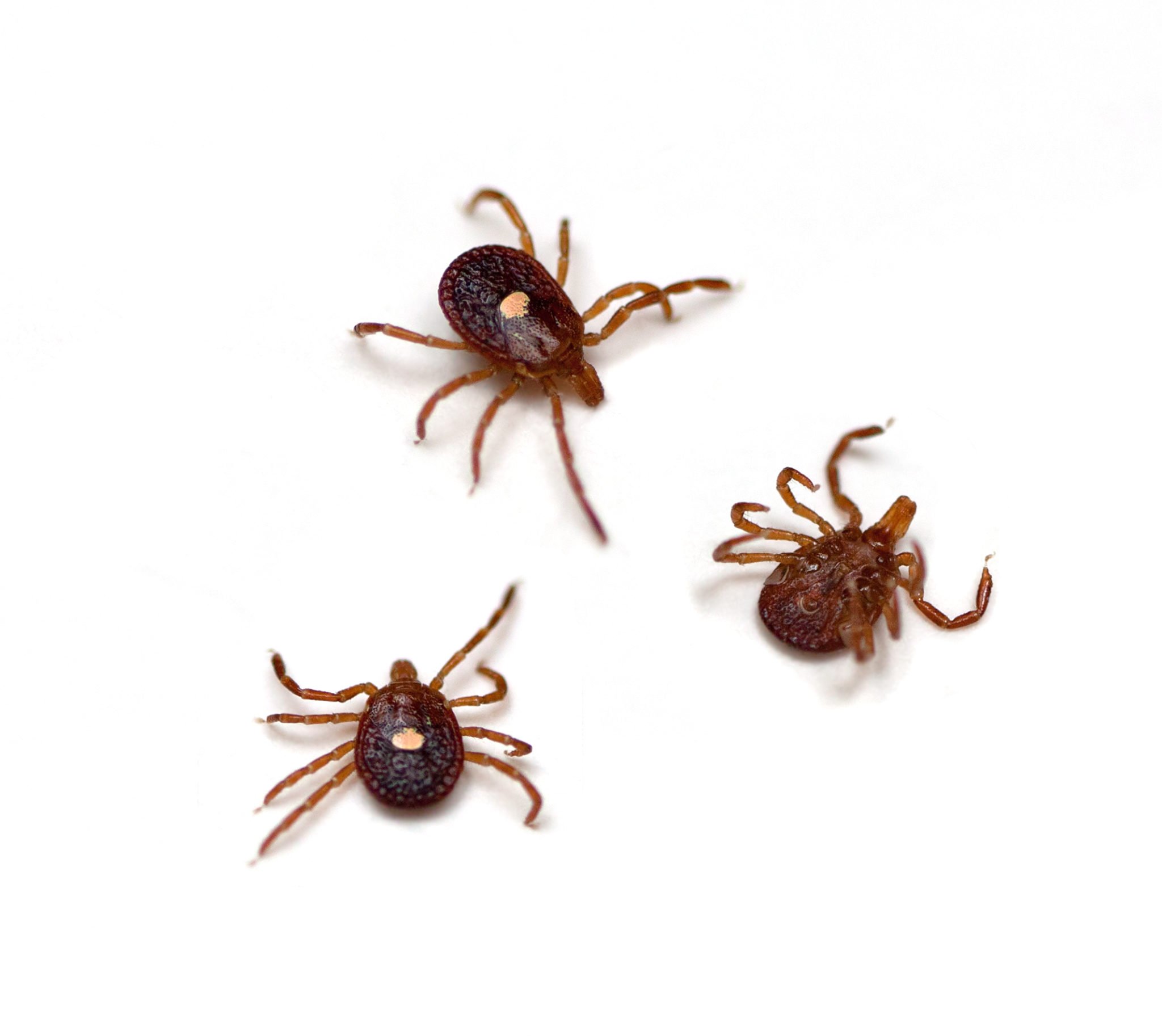It was on Tom Muir’s daily commute from Virginia to his federal-government job in DC that he knew something was very wrong.
On those drives, he started to notice that “my eyes would swell, my lips would swell. I had facial flushing, and my heart rate would go through the roof.”
For two years, Muir—who often works outdoors on his farm in Fauquier County—was having increasingly bad allergic reactions to something, but he couldn’t figure out what. He went to allergy clinics but tested negative for common food allergies. It wasn’t until a wasp sting landed him in the emergency room that he started putting the pieces together.
He told the doctors that his reactions seemed to occur any day after he ate red meat, which was often. “I used to eat bacon for breakfast, a steak for lunch, and a hamburger for dinner,” he says.
It turned out Muir had alpha-gal syndrome, named for a sugar molecule, alpha-gal, or galactose-alpha-1, 3-galactose. It’s sometimes called the “meat allergy” because those with AGS can no longer eat red meat without getting sick.
AGS is most often transmitted to humans by the lone star tick, a creepy, crawly thing that’s sometimes no bigger than a poppy seed. “Around the [Washington] area, they’re the largest variety of tick you will encounter by far,” says Holly Gaff of Old Dominion University in Norfolk, who has been studying ticks, their behaviors, and the diseases they carry.
The lone star tick gets its name not because it comes out of Texas (it doesn’t) but from the white dot, or “lone star” found on the adult female’s back. These devils are surprisingly hardy, Gaff says, able to withstand both freezing and extremely hot temperatures.
The tick is also very aggressive. It can travel at surprising speeds, and it hunts in packs to swarm its host, unlike the black-legged tick associated with Lyme disease, which hangs out in the leafy undergrowth to wait for its meal.
Says Gaff: “They’re the bully of the tick world.”
Back in 2009, when Muir was diagnosed, few doctors had heard of AGS or lone star ticks. The condition had been identified only five years earlier, when allergy researcher and immunologist Thomas Platts-Mills of the University of Virginia started studying AGS and its association with tick bites.
Once the disorder had a name, more patients were getting a diagnosis. “In the last five, six years, there’s been an increase in the number of patients who have the allergy,” says Nader Soliman, an anesthesiologist and the director of the Alternative Medicine Center in Rockville, who treats people from around the country. “Seventy percent of my Lyme patients have alpha-gal.”
Only a decade ago, small populations of lone star ticks were found in the northeastern and central-eastern United States, but as the white-tailed-deer population exploded, so did the prevalence of the lone star tick. It’s found pretty much where its favorite meal, the white-tailed deer, is found—in woods and tall grasses. But it also comes into our homes by catching rides on our shoes and our pets.
Because AGS still has no medical diagnostic code and the Centers for Disease Control and Prevention doesn’t track it, no scientifically backed numbers exist to tell us how many people have it. One lab in the US tests for presence of the alpha-gal IgE antibodies, and in 2018 it reported a total of 580,000 cases. But an online map of self-reported cases, created by those with AGS, shows them to be not just in rural environments, where there are typically more woods, but also in urban and suburban areas, including DC, Reston, Falls Church, and Greenbelt. According to a Health and Human Services advisory-subcommittee report on AGS, Virginia is a national hot spot.
There’s no cure for AGS. People who contract it have to stop consuming red meat—beef, lamb, pork, game. Antihistamines can help with reactions. Some patients are so hypersensitive that if they eat off a grill that once cooked meat, or even inhale barbecue fumes, they might be scrambling for their EpiPen or Benadryl.
Soliman has had success giving people a patented acupuncture treatment that blocks the body’s response to the allergy, triggering it to go into remission. But he says only about 150 doctors and licensed acupuncturists in the country are trained in this method.
Patients also must avoid products made with bovine gelatin and other mammal-derived ingredients. These include everyday items such as certain cosmetics, vitamins, and lotions, plus the adhesives in bandages and some medications and vaccinations.
This has proven challenging for some patients, especially during the Covid-19 pandemic.
Deborah Olsen was bitten by a tick in 2012 while gardening on the Eastern Shore, another known AGS hot spot. For years, she suffered bouts of anaphylaxis, painful welts, and trips to the hospital. It took her more than seven years to be diagnosed with AGS—all the while eliminating from her diet many things, including red meat, and reducing her time outdoors. (She eventually sold her farm and moved to a more suburban area in Delaware.) Olsen also started paying closer attention to labels on foods, medicines, and just about everything else.
In February 2020, while still suffering from AGS, she contracted Covid.
“Vetting medications that were alphagal-safe during Covid was a little challenging, but I was able to do it,” she says.
Later, when it came to the vaccine, Olsen, who is now 60, didn’t hesitate. Neither the Pfizer, Moderna, nor Johnson & Johnson vaccine contains mammal products, according to the companies. The CDC says no gelatin or preservatives are used in either of the mRNA vaccines.
Apart from vaccines, Solimon says that data about how coronavirus may impact AGS patients is extremely limited, in part because little is known about either disease.
Lyme is still a much more common disease, and not everyone bitten by a lone star tick gets AGS. The rate of transmission de-pends on a lot of factors, including a per-son’s immune health and even blood type. (AGS’s molecular structure is similar to that of an antigen already found in B and AB blood types—apparently giving people with those types some protection. People with A or O blood type are five times likelier to be diagnosed with the syndrome.)
“Allergies are weird,” says Gaff. “[Alpha-gal] is more like a dog or cat allergy. Most dogs and cats have dander, which causes the allergic reaction, but not everyone reacts to that.”
The lone star doesn’t cause just AGS. According to the CDC, the tick can transmit other nasty tick-borne diseases, including Powassan virus, ehrlichiosis, and tularemia, each with its own impact. The lone star tick and AGS can create an array of other health complications as well. The University of Virginia has conducted research linking people sensitive to the AGS gene with a much higher risk of heart disease, for example.
Muir, who must now take monthly allergy shots, has become allergic to other things: “It’s spiked my allergies to dog hair, bees, and wasp stings.”
Both Olsen and Muir eventually learned how to manage their disease. They’re very careful about what they eat, often avoiding restaurants or other places where there’s a chance of being around meat. They never leave home without their EpiPens, and they do regular tick checks.
Although Olsen doesn’t completely avoid the outdoors now, the syndrome has curtailed her activities. “I used to love swimming, hiking, roller-skating, and being very active,” she says. “I became extremely reclusive.”
“People check out of the mainstream,” says Beth Carrison, who contracted AGS at her home in Massachusetts. “Parents have been known to homeschool their AGS kids because they can’t be exposed to adhesives, glues, or crayons.”
In 2018, Carrison teamed up with Jennifer Platt, a public-health researcher at UNC who was diagnosed with another tick-borne illness, ehrlichiosis, to create Tick-Borne Conditions United, an organization aimed at educating and advocating for research on the lone star tick and lesser-known illnesses spread by ticks.
They’re working to help implement measures in the bipartisan Kay Hagan Tick Act, named in honor of former senator Kay Hagan, a Democrat from North Carolina who died in October 2019 due to complications from the tick-borne Powassan virus. Last year, $5 million was appropriated for the Tick Act for further research, surveillance, and education on tick-borne illnesses, and in total, the federal government plans to spend $91 million this year on tick-borne illnesses.
“I am talking to people who can’t work in offices where people wear perfumes or can’t smell someone’s lunch being heated up,” Carrison says. A woman with AGS told Platt that her employer put her in a building by herself to avoid triggering anaphylaxis.
There are some silver linings. Compared with Lyme, which has taken decades for just baseline research and treatments to be available, awareness of AGS has been relatively rapid. Congress is considering measures that would require the Department of Health and Human Services to create a national strategy to address tick-borne illness, including AGS.
Those diagnosed with the disease can be heartened that, if it’s properly managed, over time people can go into remission. For Muir, the need to cut out red meat brings another benefit. “It’s done wonders for my cholesterol numbers,” he says. “I am eating better, and let’s face it, it’s cheaper when you go eat.”
But, he adds, he’s still waiting for the day when AGS significantly abates so he can have a nice steak or burger for his birthday: “It’s been more than ten years.”

How to Protect Yourself From Ticks
Cover up. Measures to guard against the lone star tick are the same as for Lyme-bearing ticks: Wear a hat, a long-sleeved shirt, and long pants with the legs tucked into your socks. Keep in mind that it’s easier to spot ticks on light-colored clothes.
Use repellents. Permethrin is extremely effective at disabling ticks, not just repelling them. However, it’s toxic to humans and best applied only to clothing. Another alternative, DEET, is a mild tick repellent that can be applied to the skin. Other repellents claim to be safer for the environment, including ones offered by TickWarriors.com, which is owned by Jennifer Platt, the public-health researcher who cofounded Tick-Borne Conditions United, an advocacy group.
Tick-proof your yard. Remove leaf litter, mow the lawn frequently, and clear tall grasses around homes and at the edge of lawns. Use cedar mulch or chips to create a barrier for restricting tick migration.
Check for ticks. After coming in from outside, inspect every part of your body, including behind the knees, in elbows and armpits, and behind ears. Ticks love warm, dark places, and they can be as small as a poppy seed.
Inspect clothing, too. The best way to kill ticks is to tumble-dry clothes for ten to 15 minutes, or wash them in hot water. Cold or lukewarm water won’t kill ticks.
Remove ticks. If you do spot one, don’t panic. The CDC says a tick must be attached nine to 48 hours or more before disease bacterium can be transmitted. The best way to remove it is with tweezers. Don’t burn it out. Don’t use your fingers—if you squeeze the tick, it may spit up any pathogens it’s carrying. Don’t twist, because it could break apart. If it does and you’re unable to remove the mouth, thoroughly clean the area and wait for the skin to heal—the tick isn’t going to give you the disease if the bacterium hasn’t been transferred. Tools are available online to remove ticks, such as the Tick Key or Tick Lasso, or you can use tweezers—just make sure they’re fine-pointed for best results.
Test a worrisome tick. Bitten? For about $50, mail-order labs such as Tick Check can test ticks you mail in for common tick-borne illnesses such as Lyme. These tests aren’t done for AGS, because the allergy comes from the saliva of the lone star tick and not a specific infectious agent. Your doctor can test for AGS antibodies and will work through Viracor, the one lab in the US that tests for alpha-gal IgE antibodies.
This article appears in the July 2021 issue of Washingtonian.



















